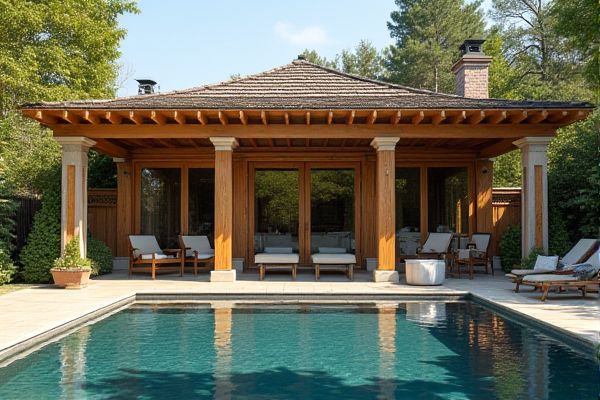
A covered pergola provides protection from sun and rain, enhancing comfort and usability throughout the year, while an open pergola offers a traditional airy design that allows natural light and ventilation to flow freely. Explore the rest of the article to understand which pergola style best suits Your outdoor living needs.
Table of Comparison
| Feature | Covered Pergola | Open Pergola |
|---|---|---|
| Protection | Provides shelter from rain, sun, and UV rays | No shelter; exposed to weather elements |
| Material | Often uses waterproof fabrics, metal, or polycarbonate panels | Typically wood or metal with open slats |
| Shade | Offers full or partial shade depending on cover type | Provides partial shade via slatted roof |
| Maintenance | Requires cleaning and occasional cover replacement | Lower maintenance; periodic cleaning of wood or metal |
| Cost | Generally higher due to added materials and installation | Usually more affordable with simpler design |
| Use Case | Ideal for all-weather outdoor living spaces | Best for decorative purposes and light shade |
Introduction to Pergolas: Covered vs. Open
Covered pergolas provide shade and protection from rain, making them ideal for outdoor spaces requiring weather shelter and extended usability. Open pergolas offer a more traditional design with an open roof structure that allows sunlight and airflow, enhancing ambiance and natural lighting in gardens or patios. Choosing between covered and open pergolas depends on climate considerations and desired function in outdoor living areas.
Defining Covered Pergolas
Covered pergolas feature a solid or translucent roof that provides protection from sun and rain, making your outdoor space usable in various weather conditions. Unlike open pergolas, which rely on sunlight and shade from slatted roofs, covered pergolas offer enhanced comfort and privacy by shielding you from harsh elements. Their durable materials often contribute to increased longevity and versatile design options for outdoor living areas.
What is an Open Pergola?
An open pergola features a roof structure composed of spaced beams or rafters, allowing sunlight and air to pass through freely while providing partial shade. This design enhances outdoor spaces by creating a visually appealing framework without blocking natural light or airflow, ideal for gardens and patios seeking an airy ambiance. You can customize an open pergola with climbing plants or retractable canopies to balance openness and protection based on your needs.
Aesthetic Differences Between Covered and Open Pergolas
Covered pergolas offer a sleek, modern aesthetic with their solid or fabric roofs that provide shade and protection, creating a cozy, enclosed outdoor space. Open pergolas feature an airy, minimalist design with slatted or lattice roofs, allowing sunlight and ventilation to enhance the natural ambiance. The choice between covered and open pergolas significantly impacts the overall visual appeal and atmosphere of outdoor living areas.
Weather Protection: Benefits and Drawbacks
A covered pergola offers superior weather protection by providing shelter from rain, sun, and wind, making outdoor spaces usable year-round. In contrast, an open pergola delivers limited protection, primarily offering shade while leaving users exposed to precipitation and strong winds. While covered pergolas enhance comfort and durability, they may reduce natural ventilation and sunlight compared to open designs.
Privacy and Shade: Covered vs. Open Options
Covered pergolas provide enhanced privacy and superior shade by incorporating solid or translucent roofing materials that block direct sunlight and limit visibility from neighbors. Open pergolas, featuring slatted or lattice roofs, allow dappled sunlight and airflow but offer less protection from sun exposure and limited privacy. Choosing a covered pergola can transform Your outdoor area into a more secluded, weather-resistant space ideal for relaxation or entertaining.
Installation and Cost Comparison
Covered pergolas generally require more complex installation due to the need for roofing materials, waterproofing, and structural support, which increases labor time and overall expenses. Open pergolas have simpler frameworks with fewer material requirements, making them quicker to install and more cost-effective for your outdoor space. Choosing between them depends on your budget and desired shelter level, with covered pergolas offering higher upfront investment but greater weather protection.
Maintenance Requirements for Both Types
Covered pergolas require less frequent cleaning and offer better protection from weather-related wear, reducing the need for repairs caused by sun, rain, or snow exposure. Open pergolas demand more regular maintenance, including sealing or staining wood surfaces to prevent damage from moisture and UV rays. You can extend the lifespan of either structure by scheduling routine inspections and timely upkeep based on the materials used.
Ideal Uses and Settings for Each Pergola Style
Covered pergolas provide excellent protection from sun and rain, making them ideal for outdoor dining areas, patios, and garden lounges where weather shelter is essential. Open pergolas enhance natural light and airflow, perfect for creating airy spaces such as walkways, garden focal points, or backyard seating areas where an open ambiance is desired. Your choice between covered and open pergolas depends on whether you prioritize weather protection or an unobstructed outdoor experience.
Choosing the Right Pergola for Your Space
Covered pergolas provide enhanced protection from sun and rain, making them ideal for outdoor spaces frequently used in varying weather conditions. Open pergolas offer a more airy, natural feel, allowing sunlight and breeze to pass through, perfect for gardens or patios focused on aesthetics rather than full shelter. When choosing the right pergola for your space, consider the climate, desired usage, and whether you prioritize weather protection or open-air ambiance.
 homyna.com
homyna.com